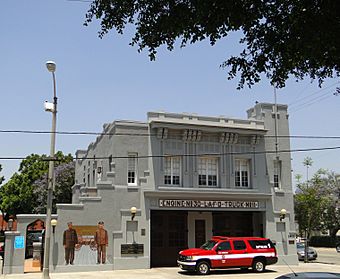Fire Station No. 30, Engine Company No. 30 facts for kids
Quick facts for kids |
|
|
Fire Station No. 30–Engine Company No. 30
|
|

File:Fire Station No. 30, June 2011
|
|
| Location | 1401 S. Central Ave., South Los Angeles, California |
|---|---|
| Architect | James Backus, Superintendent of Building, City of Los Angeles |
| Architectural style | Prairie School |
| NRHP reference No. | 09000148 |
| Added to NRHP | March 17, 2009 |
Fire Station No. 30, Engine Company No. 30 is a historic fire station in South Los Angeles, California. It was built in 1913. At first, white firefighters served a neighborhood that was mostly white.
Over time, more people from different backgrounds moved into the area. By 1924, the fire station became segregated. This meant only Black firefighters worked there. This continued until 1956, when the fire department ended segregation and became integrated. Today, the neighborhood is mostly Hispanic.
The fire station closed in 1980. The building then became the African American Firefighter Museum (AAFFM). This museum shows old fire equipment, tools, and special items. It also shares stories and photos of the first African-American firefighters in Los Angeles. You can see pictures and items from African American firefighters, officers, and women in fire service from all over the country. The museum is run by volunteers and relies on donations.
Contents
The Story of Fire Station 30
Building a Historic Fire Station
The Fire Station No. 30 building has two stories. It was designed in a style called Prairie School. Construction finished in 1913. This building has been an important part of the community for over 100 years.
A Place of Change
In 2009, Fire Station No. 30 was added to the National Register of Historic Places. This is a list of important places in the United States. It was recognized for its role in the history of African Americans in Los Angeles.
Fire Station No. 30 was one of the first two fire stations in Los Angeles where only Black firefighters worked. This segregation started in 1924. It lasted until 1956, when the Los Angeles Fire Department allowed all races to work together.
Even though segregation was unfair, these all-Black fire stations were also a source of pride. They showed the strength and community spirit of African American firefighters.
Other Important Places
Other buildings that tell similar stories are also on the National Register. These include Fire Station No. 14, which was the second all-Black fire station. Other examples are the Angelus Funeral Home and the Lincoln Theater.
Images for kids
Learn More
- Los Angeles Fire Department Museum and Memorial
- Los Angeles Fire Department






